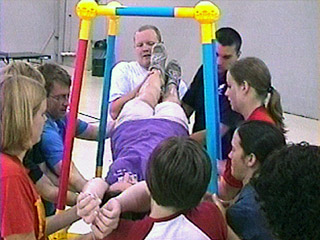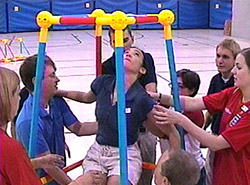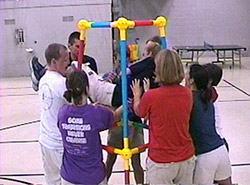Activity 21: Spider's Web



Spider's Web Activity
Activity Plan
Group Size: 10 - 15
Time: 25 - 45 minutes
Mental Intensity: 2
Physical Intensity: 3
Space: Medium
Objectives
- Brainstorm and share problem-solving strategies to pass people through the “spider’s web”
- Safely spot and support team members in the “web”
- Discuss the experience and feelings
Character Focus
Trust & Caring
Preparation
Time: 5 minutes
Materials:
1 Toobeez set
1 envelope
chart paper (optional)
Setup:
- Place the Risk Taking Note into an envelope.
- Build a rectangular-shaped tower using Toobeez (refer to photo). The tower should be approximatley six feet high. The more narrow the tower, the harder the activity.
The Challenge
As a group, earn as many points as you can by traveling through a unique pathway.
Safety Reminders!
Appropriate caution is important to conduct these activities in a safe manner. Be sure to review these reminders prior to beginning the activity, and if necessary, share reminders with the group during the activity.
- Proper spotting techniques must be reviewed prior to starting this challenge (refer to the beginning of this activity guide).
- It is ideal to have cushions or pads placed under the Toobeez structure to minimize the effects of a fall.
- All participants must be spotted as they travel through the cube.
- If your group is not physically strong enough, mature enough and/or calm enough, do not attempt this activity.
Helpful hints
- A tower with high openings is more challenging
- Rather than building the spider’s web for the group, have them build it
- Some groups may want to practice passing people through the cube prior to actually starting. Note: Allowing the group to practice on the cube itself can take away some of the unknown aspects of the activity. Consider setting limitations on the practice (time, number of tries, etc.).
Activity Instructions
- Circle up the group. Distribute or display the appropriate “Risk Taking Note” for the activity. Have one participant read it aloud twice. Provide a few moments for the participants to think about the message:
The measure of success is not whether you have a tough problem to deal with, but whether it is the same problem you have had before. - Share the following storyline with group.
Your team is traveling through the Amazon jungle, and you have encountered a magical spider's web across the path. There is no way around the spider's web, so you must get your team through it without getting caught. - Read aloud the following Activity Challenge Box to the group.
Challenge: As a group, earn as many points as you can by traveling through a unique pathway. Follow the guidelines below:- Each team member must pass through the spider’s web using his/her own unique pathway. Once a pathway is used, that unique sequence of travel cannot be used again
- The spider’s web must not be touched by anything
- Participants may not jump or dive through openings
- Team members may not be launched through the openings
- Anyone traveling through the spider’s web must be spotted
- No other equipment may be used in this activity
- The group MUST complete this activity in a safe manner or the activity will be stopped
- If any guidelines are broken, the group may be given a penalty (see step #8)
- Before the participants attempt an activity challenge, have the group work through the following six steps:
- Circle up
- Know and understand the challenge and the guidelines
- Brainstorm
- Make a plan
- Do the plan
- Evaluate results and adjust as necessary
- Gather the team around the cube and explain the point system.
One point is earned when passing from a lower hole to a lower hole.
Two points are earned when passing from a lower hole to an upper hole.
Three points are earned when passing from an upper hole to an upper hole. - Teach or review proper spotting techniques (provided in the introduction to this manual) and emphasize the importance of safety.
- Be sure to monitor the group for safety as they attempt the activity.


- If a touch occurs, choose one of the following penalties: A) everyone starts again, B) only one person has to travel back through, C) the group may not communicate verbally for five minutes, or D) a combination of these.
- If participants get stuck, have the students circle up again. Here are some suggested questions to help guide the group back on track*:
- What is working?
- What ideas have you not tried yet that someone suggested?
- If your group is still struggling OR if you feel your group would benefit from an additional challenge, present a variation provided on the next page.
- After the activity, move to the debriefing questions for discussion.
Problem Solving Sequence:
Activity Variations
- Providing opportunity for new group leadership.
There is a tendency for one or two people to be the most vocal. Have them suddenly become mute so that they can still participate, but can not speak.
Debriefing the Activity
Use these debriefing questions as a guide for your discussion. Select the questions you feel will best benefit your group. It is not mandatory to cover every question. If possible, record the group’s responses on flip chart paper so all comments are displayed. Make sure to let everyone share their ideas, and remind participants that everyone’s opinions and feelings are important!
Base questions for debriefing:
- What did you just do together?
- How did you feel while you did the activity?
- What was one of the challenges of doing this activity?
- What did the group have to do or believe to be successful?
If the group was unable to complete the task in the given time:
- Why do you think it was so difficult to make it through the spider web?
- Since you were not able to solve the problem, does it mean your group is a failure? (Push the group to respond with more than a “yes” or “no” and to instead point out and discuss what they learned.)
- What changes would you make in how you communicated?
Additional questions: Choose which ones are the most appropriate:
- What did passing people through spider’s web signify?
- What advice would you give to another group working on this activity?
- Did you try different ideas? If so, why did you change your approach?
Close on a Positive Note
Sum up the different ideas and feelings that you heard expressed, and restate ideas and learning moments the participants shared. Then, read the Risk Taking Note out loud again, and ask people to discuss what they think this note means. Discuss what they thought it meant at the beginning and what they think it means now.
* (ˆ) Do not provide the participants with answers. Allow them to work together.





